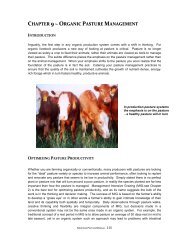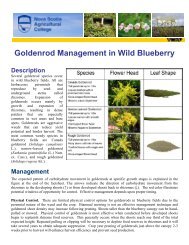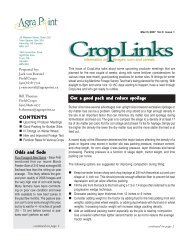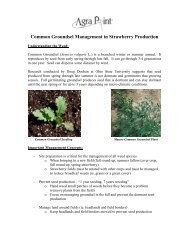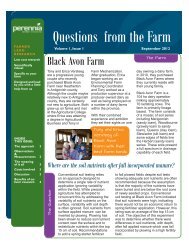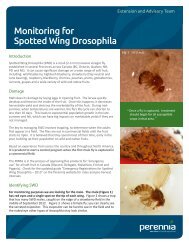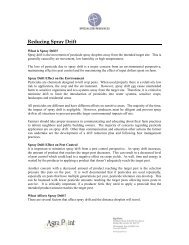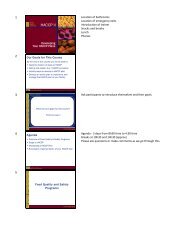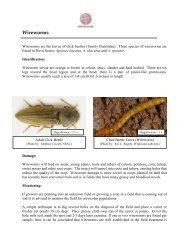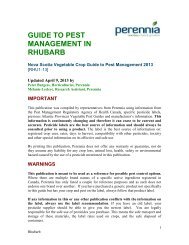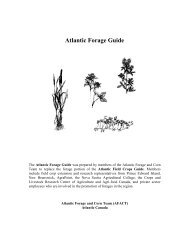Business Planning and Economics of Apple Orchard ... - Perennia
Business Planning and Economics of Apple Orchard ... - Perennia
Business Planning and Economics of Apple Orchard ... - Perennia
Create successful ePaper yourself
Turn your PDF publications into a flip-book with our unique Google optimized e-Paper software.
<strong>Business</strong> <strong>Planning</strong> <strong>and</strong> <strong>Economics</strong><br />
<strong>of</strong> <strong>Apple</strong> <strong>Orchard</strong> Establishment<br />
<strong>and</strong> Cost <strong>of</strong> Production in Nova Scotia<br />
Nova Scotia Department <strong>of</strong> Agriculture<br />
<strong>Business</strong> Development <strong>and</strong> <strong>Economics</strong> Division<br />
Fall, 2009<br />
1
<strong>Business</strong> <strong>Planning</strong> <strong>and</strong> <strong>Economics</strong> <strong>of</strong><br />
<strong>Apple</strong> <strong>Orchard</strong> Establishment <strong>and</strong> Cost<br />
<strong>of</strong> Production in Nova Scotia<br />
Prepared by: Lori Kittilsen, <strong>Business</strong> Development Specialist, Nova Scotia Department<br />
<strong>of</strong> Agriculture<br />
Although care has been taken in preparing the information contained in this document, the Nova Scotia<br />
Department <strong>of</strong> Agriculture does not <strong>and</strong> cannot guarantee the accuracy there<strong>of</strong>. Anyone using this<br />
information is doing so at her/his own risk, thereby releasing both the Department <strong>and</strong> the Province <strong>of</strong><br />
Nova Scotia from accepting any <strong>and</strong> all responsibilities <strong>and</strong>/or liabilities for any person or persons who<br />
may suffer loss or damage by its use.<br />
Introduction<br />
The Annapolis Valley <strong>of</strong> Nova Scotia is the centre <strong>of</strong> apple production on Canada’s<br />
Eastern Seaboard. Nova Scotia is one <strong>of</strong> the most northerly growing regions in North<br />
America, giving gives Nova Scotia’s commercial apple producing region a relatively<br />
short <strong>and</strong> cool growing season. Within Canada, New Brunswick is the only province<br />
producing apples with a shorter <strong>and</strong> cooler season. With respect to the amount <strong>of</strong><br />
precipitation, Nova Scotia surpasses most North American apple producing regions.<br />
The annual precipitation for Kentville Nova Scotia is 1,211 mm which means that most<br />
growers in Nova Scotia do not need to rely on irrigation to produce a crop. The short,<br />
cool <strong>and</strong> moist growing season <strong>of</strong> the Annapolis Valley can provide a competitive<br />
advantage to growers with respect to input costs <strong>and</strong> apple quality. One <strong>of</strong> the greatest<br />
climatic advantages that Nova Scotia has over other apple producing regions is the<br />
ability to produce highly coloured apples due to the cool evening temperatures in late<br />
summer <strong>and</strong> the fall combined with good light diffusion. The other advantages Nova<br />
Scotia growers have with respect to weather are, that Nova Scotia orchards are less<br />
prone to adverse weather events <strong>and</strong> frost damage. Nova Scotia apples are also less<br />
prone to calcium deficiency which is advantageous to the Nova Scotia growers <strong>and</strong><br />
contributes to the ability to produce quality fruit.<br />
The Nova Scotia Industry<br />
The growing <strong>of</strong> apples in Nova Scotia can be traced back more than 400 years to the<br />
arrival <strong>of</strong> the first French settlers in the region <strong>of</strong> Annapolis Royal. Nova Scotia currently<br />
produces an annual average <strong>of</strong> approximately 2.5 million bushels <strong>of</strong> apples, which is<br />
equal to between eight <strong>and</strong> nine percent <strong>of</strong> the Canadian production or 1% <strong>of</strong> the US<br />
production. The farm gate value <strong>of</strong> Nova Scotia’s annual apple crop is approximately<br />
$13 million. Over the past century the tree fruit sector in Nova Scotia has gone through<br />
significant change with the consolidation <strong>of</strong> the industry, changes in cultivars <strong>and</strong> the<br />
development <strong>of</strong> a packing house <strong>and</strong> processing industry.<br />
Nova Scotia Department <strong>of</strong> Agriculture<br />
<strong>Business</strong> Development <strong>and</strong> <strong>Economics</strong> Division<br />
Fall, 2009<br />
2
Nova Scotia is currently <strong>and</strong> is likely to remain a net exporter <strong>of</strong> apples due to the<br />
volume <strong>of</strong> apples produced relative to the available customers in the domestic market<br />
place.<br />
Objectives<br />
The purpose <strong>of</strong> this report is to provide individuals interested in the production <strong>of</strong> apples<br />
a guide to developing a plan <strong>and</strong> an underst<strong>and</strong>ing <strong>of</strong> the costs associated with the<br />
establishment <strong>and</strong> operation <strong>of</strong> an orchard. This report reflects the management<br />
practices <strong>of</strong> growers in Nova Scotia at the present time <strong>and</strong> the current economic<br />
conditions that can influence the establishment <strong>and</strong> operating costs. The costs in this<br />
document represent an average scenario <strong>and</strong> the expenses will vary depending on the<br />
grower <strong>and</strong> the site.<br />
Methods <strong>and</strong> Procedures<br />
The information presented in this report was gathered through economic reports from<br />
other apple growing regions in Canada, online <strong>and</strong> printed resources, <strong>and</strong> discussions<br />
with Nova Scotia growers, specialists <strong>and</strong> agribusiness operators.<br />
Overview <strong>of</strong> <strong>Orchard</strong> Establishment<br />
In the apple growing business, returns are a function <strong>of</strong> costs (capital + operating) <strong>and</strong><br />
revenue which is a function <strong>of</strong> yield, quality, price <strong>and</strong> cultivar.<br />
The cost associated with establishing <strong>and</strong> operating an orchard can vary from site to<br />
site <strong>and</strong> from operator to operator due to the significant variation in the cost <strong>of</strong> l<strong>and</strong>,<br />
labour, machinery <strong>and</strong> materials. During the initial years <strong>of</strong> orchard establishment the<br />
main costs at play are the capital costs such as the l<strong>and</strong> purchase, l<strong>and</strong> preparation,<br />
labour, trees, support system materials, pest management materials <strong>and</strong> interest on<br />
debt. There is significant variation in the cost <strong>of</strong> l<strong>and</strong> preparation depending on the<br />
need for clearing, leveling, <strong>and</strong> drainage. However it has been found that the added<br />
expenses <strong>of</strong> l<strong>and</strong> improvement will result in an earlier <strong>and</strong> more consistent crop, thus<br />
bringing an earlier return on the investment. Variation in the establishment costs are<br />
affected by many cultural practices like cultivar, planting density, training systems, pest<br />
management <strong>and</strong> the location <strong>of</strong> the site. A new grower or someone considering entry<br />
into apple production must carefully consider the advantages <strong>and</strong> disadvantages <strong>of</strong> the<br />
site <strong>and</strong> cultivar selection because these decisions will have a significant impact on the<br />
pr<strong>of</strong>itability <strong>of</strong> the planting.<br />
Just knowing the establishment <strong>and</strong> production costs is not enough to make an<br />
educated decision whether to undertake apple production as a business or not. The<br />
individual must give consideration to the potential for pr<strong>of</strong>itability which is directly related<br />
to cultivar, yield <strong>and</strong> price. Yield is a function <strong>of</strong> site, soil, cultivar <strong>and</strong> management to<br />
Nova Scotia Department <strong>of</strong> Agriculture<br />
<strong>Business</strong> Development <strong>and</strong> <strong>Economics</strong> Division<br />
Fall, 2009<br />
3
mention a few, where the price is determined by the current market <strong>and</strong> quality.<br />
Therefore the price is a function <strong>of</strong> your ability to grow <strong>and</strong> market a quality product.<br />
<strong>Apple</strong> packers in Nova Scotia are interested in marketing a premium quality apple, <strong>and</strong><br />
are very interested in securing the highest quality apples.<br />
The establishment <strong>of</strong> an orchard is a long term investment, with orchards having a life<br />
expectancy <strong>of</strong> 20 years. It is important that the establishment <strong>of</strong> an orchard be well<br />
planned including the site planning, the planting <strong>and</strong> the tree care. The high density<br />
plantings can require a grower investing in excess <strong>of</strong> $20,000 per acre for the<br />
establishment. The extensive planning for high density plantings will pay <strong>of</strong>f in<br />
maximizing yields <strong>and</strong> returns over the productive life <strong>of</strong> the orchard. Mistakes made in<br />
the planning <strong>and</strong> planting can be very costly <strong>and</strong> are difficult to correct in later years. It<br />
is paramount that careful attention be paid to the site selection, soil preparation, tree<br />
quality, cultivar selection <strong>and</strong> early tree care.<br />
<strong>Orchard</strong> – Site Selection<br />
The success <strong>of</strong> an orchard is closely<br />
linked to the location; therefore, a<br />
new orchard site needs to be<br />
thoroughly investigated as to the<br />
micro-climate, soil <strong>and</strong> topography<br />
best suited to the production <strong>of</strong><br />
apples.<br />
<strong>Orchard</strong> sites should preferably be on<br />
gently slopping hillside with good air<br />
drainage to provide greater protection<br />
against frost <strong>and</strong> freezing injury. It is<br />
also preferred that site not be exposed to consistently strong winds. The soil should<br />
have a minimum rooting depth <strong>of</strong> 60 cm. It is important that the soil on a potential site<br />
be thoroughly investigated to determine the soil constraints <strong>of</strong> the site <strong>and</strong> to properly<br />
plan the modifications <strong>of</strong> the soil including such things as removal <strong>of</strong> excess water, deep<br />
soil manipulation <strong>and</strong> nutrient modification.<br />
Soil<br />
Soil analysis also needs to be conducted; the optimal level <strong>of</strong> soil pH for fruit tree growth<br />
is 6.5. This level <strong>of</strong> pH increases the availability <strong>of</strong> important nutrients including<br />
nitrogen, phosphorous, potassium, magnesium, calcium <strong>and</strong> sulfur. This level <strong>of</strong> pH will<br />
also increase micro-organism activity which will speed up the decomposition <strong>of</strong> organic<br />
materials, <strong>and</strong> aids in tree growth. Although apple trees can still grow in soil that has a<br />
pH as low as 5, acidic soils (pH <strong>of</strong> less than 5) are high in aluminum <strong>and</strong> manganese,<br />
which are soluble at this level <strong>and</strong> can directly affect tree growth. The application <strong>of</strong> lime<br />
Nova Scotia Department <strong>of</strong> Agriculture<br />
<strong>Business</strong> Development <strong>and</strong> <strong>Economics</strong> Division<br />
Fall, 2009<br />
4
on acidic soils can raise the pH to a more productive level, also limiting these toxic<br />
substances.<br />
Trees<br />
The first step to determining the tree requirements is to measure the field <strong>and</strong> decide on<br />
the spacing that will suit the desired management techniques. You may wish to consult<br />
with a tree fruit specialist at this point in the planning. The success <strong>of</strong> the new orchard<br />
planting is highly influenced by the quality <strong>of</strong> the nursery trees that are planted. The<br />
nursery stock should be vigorous, one or two year old trees with lateral shoots <strong>and</strong> high<br />
density. Where early production is required it is advised to plant one-year old feathered<br />
trees with a minimum <strong>of</strong> eight lateral shoots. The trees should be dormant, free from<br />
freezing <strong>and</strong> other injury <strong>and</strong> should have never been subjected to drying conditions. It<br />
is important that the trees be planted as soon as possible after they are received. Spring<br />
time (April-May) is the best time for planting nursery stock, as soon as the soil is ready.<br />
<strong>Apple</strong> Cultivars for Nova Scotia<br />
You might think that today there are a wide range <strong>of</strong> apple cultivars, however you might<br />
be interested to know that over a century ago there was up to 1000 different cultivars<br />
available in the United States <strong>and</strong> Canada. Over many seasons growers withdrew a<br />
number <strong>of</strong> cultivars that were not favored by consumers or did not store well. Presently<br />
there are at least 30 different cultivars that are grown in Nova Scotia for sale<br />
commercially, however, the selection <strong>of</strong> locally gown cultivars on the shelves <strong>of</strong> the<br />
major retailers is significantly smaller. Consumers dem<strong>and</strong> the cultivars best suited for<br />
their uses such as baking, fresh eating, freezing, or salads. The apple cultivars most in<br />
dem<strong>and</strong> on the market include (Listed in order <strong>of</strong> Harvest):<br />
• Gravensteins<br />
• McIntosh<br />
• Cortl<strong>and</strong><br />
• Gala<br />
• Honeycrisp<br />
• Spartan<br />
• Red Delicious<br />
• Golden Delicious<br />
• Idared<br />
• Northern Spy<br />
Nova Scotia Department <strong>of</strong> Agriculture<br />
<strong>Business</strong> Development <strong>and</strong> <strong>Economics</strong> Division<br />
Fall, 2009<br />
5
Commonly Grown Cultivars for Nova Scotia<br />
Gravenstein: Medium to large, round, red blushed with yellow<br />
background. Flesh is cream, juicy <strong>and</strong> tart. Excellent for fresh eating,<br />
sauce <strong>and</strong> freezing. Good for salads <strong>and</strong> baking.<br />
McIntosh: Medium, round, red to red blushed. Flesh is white, crisp,<br />
juicy, sub-acid <strong>and</strong> browns quickly. McIntosh apples are excellent for<br />
fresh eating <strong>and</strong> good for sauce.<br />
Cortl<strong>and</strong>: Medium to large, round to round conic striped or blushed<br />
red. Flesh is white, sub-acid <strong>and</strong> non-browning. Excellent for fresh<br />
eating, salads <strong>and</strong> sauce. Good for pies, baking <strong>and</strong> freezing.<br />
Gala: Medium to small, conical shape, streaked with bright orange red<br />
<strong>and</strong> with golden yellow background. Mild, sweet flavor, s<strong>of</strong>ter for<br />
eating <strong>and</strong> favored for apple slices.<br />
Honeycrisp: Large, bright red with yellow background. Explosively<br />
crisp, firm, sweet <strong>and</strong> juicy. Exceptional for fresh eating, salads, sauce<br />
<strong>and</strong> cooking.<br />
Spartan: Medium, round, red blushed. Flesh is cream, crisp, <strong>and</strong><br />
lightly aromatic <strong>and</strong> sub-aid. Spartans are considered good for fresh<br />
eating, salads <strong>and</strong> sauce.<br />
Red Delicious: Small to large conic, striped or blushed red. Flesh is<br />
greenish cream, juicy <strong>and</strong> sweet. Red Delicious apples' sweet taste<br />
makes them excellent for fresh eating.<br />
Golden Delicious: Yellow to yellow-green, sweet/bl<strong>and</strong> flavor, juicy<br />
<strong>and</strong> crisp flesh that resists browning, all-purpose but do lose some<br />
flavor when cooked.<br />
Idared: Medium to large, round oblong, blushed red. Flesh is cream,<br />
firm <strong>and</strong> sub-acid after storage. Excellent for pies <strong>and</strong> baking. Good<br />
for fresh eating, salads, sauce <strong>and</strong> freezing. Available November to<br />
July; primarily February to July.<br />
Northern Spy: Large, sweet-tart apple, red skin with yellow streaking,<br />
all-purpose apple. also called spy apple. Premium pie apple.<br />
Nova Scotia Department <strong>of</strong> Agriculture<br />
<strong>Business</strong> Development <strong>and</strong> <strong>Economics</strong> Division<br />
Fall, 2009<br />
6
Establishment <strong>and</strong> Cost <strong>of</strong> Production Assumptions<br />
• It has been assumed that the development is a 20 acre orchard <strong>and</strong> there will be<br />
a purchase <strong>of</strong> a tractor <strong>and</strong> other related equipment such as a mower <strong>and</strong><br />
sprayer at an investment <strong>of</strong> $50,000 borrowed at a fixed rate 6.5% for 10 years.<br />
• For the purpose <strong>of</strong> calculating the l<strong>and</strong> tax, a rate <strong>of</strong> $0.80/$100 was used.<br />
• The l<strong>and</strong> preparation costs are based on l<strong>and</strong> in a pasture state prior to planting.<br />
• The cost <strong>of</strong> l<strong>and</strong> has not been included in this study because <strong>of</strong> the great deal <strong>of</strong><br />
variation in l<strong>and</strong> prices <strong>and</strong> values. It is therefore important to remember that if<br />
you are using this information in the planning <strong>of</strong> your own development, you will<br />
need to allow for the l<strong>and</strong> expense in the calculation <strong>of</strong> your own establishment<br />
<strong>and</strong> operating costs.<br />
• Costs associated with general farm overhead like accounting, legal, <strong>of</strong>fice <strong>and</strong><br />
general farm maintenance have not been included due to the variability that<br />
exists from situation to situation.<br />
• The information in this document looks at the establishment <strong>of</strong> orchards<br />
unsupported at 300 trees/acre <strong>and</strong> supported at 400, 600 <strong>and</strong> 800 trees/acre.<br />
• The establishment is based on the higher valued apple cultivars.<br />
• For the purpose <strong>of</strong> this report year one is the pre-planting year.<br />
Nova Scotia Department <strong>of</strong> Agriculture<br />
<strong>Business</strong> Development <strong>and</strong> <strong>Economics</strong> Division<br />
Fall, 2009<br />
7
Costs <strong>and</strong> Returns <strong>of</strong> <strong>Apple</strong> Production<br />
Variable Costs<br />
The variable costs are those costs that change directly with an increase or decrease in<br />
acreage. Trees, training materials, pesticides, fertilizers, labour <strong>and</strong> operating<br />
expenses for machinery are examples <strong>of</strong> variable costs.<br />
Fixed Costs<br />
Fixed cost or overhead costs do not change as a result <strong>of</strong> an increase or decrease in<br />
acreage. Some examples <strong>of</strong> fixed costs are machinery (depreciation <strong>and</strong> interest), <strong>and</strong><br />
taxes.<br />
Year 1: Pre-planting - Costs<br />
In the year prior to planting the orchard, the selected location will require preparation for<br />
the planting <strong>of</strong> the trees. The site will, in most cases, require installation <strong>of</strong> tile drainage.<br />
Following the installation <strong>of</strong> the tile drain, the site will require tilling, fumigation, deep<br />
ripping <strong>and</strong> the application <strong>of</strong> lime, fertilizer <strong>and</strong> manure according to recommendations<br />
from soil testing. Once the l<strong>and</strong> preparations are complete a cover crop should be<br />
planted for the winter to prevent erosion.<br />
Table 1. Pre-Planting year 1 costs (all plantings)<br />
Variable Costs<br />
Cost/Acre<br />
Tile Drainage $2000<br />
Deep Ripping $500<br />
L<strong>and</strong> Preparation (seed bed condition) $500<br />
Fumigation $1200<br />
Soil Testing <strong>and</strong> Amendments $126<br />
Cover Crop $35<br />
Tractor <strong>and</strong> Equipment Expenses $200<br />
Labour $300<br />
Total Variable Costs $4,861<br />
Fixed Costs<br />
Interest <strong>and</strong> Depreciation Tractor <strong>and</strong> Equipment $560<br />
Taxes (l<strong>and</strong>) $28<br />
Total Fixed Costs $588<br />
Total Cost for Pre-planting Year $5,449<br />
Nova Scotia Department <strong>of</strong> Agriculture<br />
<strong>Business</strong> Development <strong>and</strong> <strong>Economics</strong> Division<br />
Fall, 2009<br />
8
Year 2: Planting Year – Costs<br />
It is in the year <strong>of</strong> planting that there is a requirement for a significant infusion <strong>of</strong> cash<br />
into the orchard. Labour is a very large part <strong>of</strong> the cost in the planting year, as is the<br />
cost <strong>of</strong> supplies for the support system <strong>and</strong> the trees themselves. There will be<br />
variation in the requirements for some things like pesticides, fertilizer, manure <strong>and</strong> lime.<br />
The labour expense will vary depending on the amount <strong>of</strong> labour you need to hire, the<br />
availability <strong>of</strong> the labour, <strong>and</strong> the wage expected by the labour pool available to you at<br />
the time <strong>of</strong> planting. If you are using your own labour <strong>and</strong> family labour it is important to<br />
remember that even if you are not using cash to pay for it directly it still has a value <strong>and</strong><br />
the value must be accounted for in all financial projections.<br />
Table 2. Establishment Costs per acre – Year 2: Planting Year<br />
Unsupported<br />
Trees 300<br />
Supported<br />
Trees 400<br />
Supported<br />
Trees 600<br />
Supported<br />
Trees 800<br />
Variable Costs<br />
Soil Testing <strong>and</strong><br />
Amendments $400 $400 $400 $400<br />
Tractor <strong>and</strong> Equipment<br />
Expenses $200 $200 $200 $200<br />
Labour $1,500 $1,500 $1,500 $1,500<br />
Trees ($11/tree) $3,300 $4,400 $6,600 $8,800<br />
Tree Support $0 $1,800 $2,700 $3,600<br />
Insect, Pest <strong>and</strong> Weed<br />
control $100 $100 $100 $100<br />
Total Variable Expenses $5,500 $8,400 $11,500 $14,600<br />
Fixed Costs<br />
Taxes (l<strong>and</strong>) $28 $28 $28 $28<br />
Interest <strong>and</strong> Depreciation<br />
Tractor <strong>and</strong> Equipment $560 $560 $560 $560<br />
Total Fixed Expenses $588 $588 $588 $588<br />
Total Expenses $6,088 $8,988 $12,088 $15,188<br />
Nova Scotia Department <strong>of</strong> Agriculture<br />
<strong>Business</strong> Development <strong>and</strong> <strong>Economics</strong> Division<br />
Fall, 2009<br />
9
Year 3: Growth Year<br />
In year three, the trees are left to grow <strong>and</strong> establish themselves. There will be some<br />
input this year in the areas <strong>of</strong> labour, pesticides <strong>and</strong> fertilizer. In year three there is no<br />
expectation for revenue. In the growth year the cost will be similar in all plantings.<br />
Table 3. Establishment Costs per acre – Year 3: Growth Year<br />
Variable Costs<br />
All <strong>Orchard</strong>s<br />
Soil Testing <strong>and</strong> Amendments $400<br />
Tractor <strong>and</strong> Equipment Expenses $200<br />
Labour $1,000<br />
Insect, Pest <strong>and</strong> Weed control $200<br />
Thinning (h<strong>and</strong>) $90<br />
Total Variable Expenses $1,890<br />
Fixed Costs<br />
Taxes (l<strong>and</strong>) $28<br />
Interest <strong>and</strong> Depreciation Tractor<br />
<strong>and</strong> Equipment $560<br />
Total Fixed Expenses $588<br />
Total Expenses $2,478<br />
Year 4 <strong>and</strong> Beyond: Production Years<br />
It is in the fourth year <strong>of</strong> the establishment when the higher density orchard plantings<br />
(600+ Supported Trees/acre) will begin to yield some return. As the orchard begins to<br />
produce fruit it will take a number <strong>of</strong> years to reach full production <strong>of</strong> a mature orchard.<br />
The density <strong>of</strong> the planting impacts the time it takes to reach the mature yield. The<br />
unsupported orchard planting will not reach the expected mature yield until year 14,<br />
however the supported orchard at 800 trees/acre should reach the mature yield in year<br />
7. Once the orchard is in a mature state the expected yield is 800 bushel/acre <strong>and</strong> the<br />
variable cost <strong>of</strong> production is approximately $4800/acre.<br />
Nova Scotia Department <strong>of</strong> Agriculture<br />
<strong>Business</strong> Development <strong>and</strong> <strong>Economics</strong> Division<br />
Fall, 2009<br />
10
Treatment <strong>of</strong> Establishment Costs<br />
The establishment <strong>of</strong> an orchard requires that a grower manage four successive years<br />
<strong>of</strong> establishment costs prior to any revenue being received. In order to evaluate the<br />
orchard enterprise it is <strong>of</strong>ten necessary to accumulate the establishment costs until such<br />
time as a crop is harvested <strong>and</strong> revenue is received. In order to do this, the variable<br />
establishment costs in each <strong>of</strong> the three years along with their respective interest<br />
charges are accumulated to the fourth year using an interest rate <strong>of</strong> 6.5% compounded<br />
annually. The total compounded amount represents the variable cost <strong>of</strong> establishment<br />
per acre <strong>of</strong> orchard that is to be repaid over a period <strong>of</strong> years <strong>of</strong> harvesting.<br />
Table 4. Establishment Costs per acre<br />
Unsupported<br />
Trees 300<br />
Supported<br />
Trees 400<br />
Supported<br />
Trees 600<br />
Supported<br />
Trees 800<br />
Preplanting Costs (variable) $4,861 $4,861 $4,861 $4,861<br />
Planting Costs (variable) $5,500 $8,400 $11,500 $14,600<br />
Growth Year 3 Costs<br />
(variable) $1,890 $1,890 $1,890 $1,890<br />
Growth Year 4 Costs<br />
(variable) $1,890 $1,890<br />
Total Variable Cost <strong>of</strong><br />
Establishment $14,141 $17,041 $18,251 $21,351<br />
Compounded Interest $2,705 $3,270 $2,455 $2,858<br />
Total Variable Cost <strong>of</strong><br />
Establishment +<br />
Compounded Interest $16,846 $20,311 $20,706 $24,209<br />
Interest Rate on<br />
Establishment cost 6.50% 6.50% 6.50% 6.50%<br />
Term 10 10 10 10<br />
Yearly Payment $2,343 $2,825 $2,880 $3,368<br />
To maintain a straightforward approach to production costs, it is necessary to assume<br />
constant costs <strong>and</strong> returns for each <strong>of</strong> the successive harvest years. It is for the same<br />
reason that the total compounded cost <strong>of</strong> establishment is amortized <strong>and</strong> the repayment<br />
<strong>of</strong> these costs is divided equally over the harvest years. By assuming that the<br />
establishment <strong>of</strong> the orchard increases the asset value <strong>of</strong> the l<strong>and</strong>, the grower is able to<br />
depreciate the costs annually over a defined number <strong>of</strong> years <strong>of</strong> actual harvesting.<br />
Table 4 above shows the amortization <strong>of</strong> the total three year establishment cost over a<br />
10 year period at an interest rate <strong>of</strong> 6.5% for each <strong>of</strong> the planting densities.<br />
Nova Scotia Department <strong>of</strong> Agriculture<br />
<strong>Business</strong> Development <strong>and</strong> <strong>Economics</strong> Division<br />
Fall, 2009<br />
11
Revenue<br />
With the production <strong>of</strong> apples, the revenue or return on the investment does not begin<br />
until the fourth year, however, it is not until year 7 or later that a grower should expect<br />
the orchard to be mature <strong>and</strong> to produce a full yield. On average, a grower practicing<br />
best management practices in Nova Scotia should expect a mature yield to be about<br />
800 bushel/acre.<br />
The price that a grower receives for the apples produced is a function <strong>of</strong> cultivar <strong>and</strong><br />
quality. It is important that potential growers underst<strong>and</strong> there is a correlation between<br />
cultivar <strong>and</strong> price. The current farm gate value for high valued apples depending upon<br />
quality(or pack-out) ranges from $110 - $500/bin. Each bin <strong>of</strong> apples contains 17<br />
bushels so the price per bushel ranges between $6.47 - $29.41/bushel.<br />
Contribution Margin<br />
The contribution margin is the difference between the revenue generated <strong>and</strong> the<br />
expenses used to generate the revenue. The contribution margin must provide funds to<br />
cover the other expenses such as overhead, loan payments <strong>and</strong> capital expenses. The<br />
contribution margin on a mature orchard producing 800 bushels per acre is dependant<br />
on the price received for the apples, which is a function <strong>of</strong> the cultivar <strong>and</strong> quality.<br />
Table 5. Price <strong>and</strong> Contribution Margin<br />
Price<br />
Contribution Margin<br />
$10.00/bushel $2,334<br />
$12.50/bushel $4,134<br />
$15.00/bushel $5,934<br />
$20.00/bushel $9,534<br />
$25.00/bushel $13,134<br />
$30.00/bushel $16,734<br />
Nova Scotia Department <strong>of</strong> Agriculture<br />
<strong>Business</strong> Development <strong>and</strong> <strong>Economics</strong> Division<br />
Fall, 2009<br />
12
Breakeven Analysis<br />
Table 6. Breakeven Analysis per acre<br />
Financing<br />
No<br />
Yes<br />
Planting Density Price/bushel<br />
$10<br />
Price/bushel<br />
$12.50<br />
Price/bushel<br />
$15<br />
Price/bushel<br />
$20<br />
Price/bushel<br />
$30<br />
300 Non-supported 25 years 17 years 14 years 11 years 9 years<br />
400 supported 24 16 15 11 9<br />
600 supported 22 14 11 9 8<br />
800 supported 22 13 11 9 7<br />
300 Non-supported 30+ years 22 years 17 years 13 years 10 years<br />
400 supported 30+ 24 18 14 11<br />
600 supported 30+ 22 16 12 9<br />
800 supported 30+ 23 17 12 8<br />
It can be easily seen from table 6 that the price received for the crop <strong>and</strong> the<br />
requirement for financing the establishment both have a significant impact on the<br />
number <strong>of</strong> years it takes to break even on the orchard enterprise. In all cases the<br />
breakeven does not include principle or interest payments on l<strong>and</strong>.<br />
L<strong>and</strong> Purchase<br />
The price <strong>of</strong> l<strong>and</strong> which is suitable for the establishment <strong>of</strong> an orchard will vary<br />
considerably depending on a number <strong>of</strong> factors such as:<br />
• Location<br />
• Site suitability<br />
• Dem<strong>and</strong><br />
• Local economy<br />
Conclusion<br />
It is obvious from the information presented in this report that there is a significant<br />
investment <strong>of</strong> time <strong>and</strong> money required for the establishment <strong>of</strong> an orchard in Nova<br />
Scotia. The growing <strong>of</strong> apples requires growers to pay close attention to both the<br />
production <strong>and</strong> financial details in order to ensure the crop has adequate yield <strong>and</strong><br />
quality <strong>and</strong> to provide a return on the investment. If the establishment <strong>of</strong> the orchard<br />
does not require external financing, there is significantly less pressure on the finances<br />
<strong>and</strong> the breakeven on the investment occurs much sooner as seen in table 9.<br />
Careful planning prior to establishment <strong>and</strong> close attention to detail during production<br />
are essential for the successful production <strong>of</strong> apples in Nova Scotia.<br />
Nova Scotia Department <strong>of</strong> Agriculture<br />
<strong>Business</strong> Development <strong>and</strong> <strong>Economics</strong> Division<br />
Fall, 2009<br />
13
<strong>Business</strong> <strong>Planning</strong> Resources for Establishment <strong>of</strong> an<br />
<strong>Orchard</strong><br />
There are a number <strong>of</strong> useful resources available to individuals wishing to establish an<br />
orchard in Nova Scotia, many <strong>of</strong> which are available by contacting one <strong>of</strong> the following:<br />
Nova Scotia Department <strong>of</strong> Agriculture –<br />
<strong>Business</strong> Development <strong>and</strong> <strong>Economics</strong> Division<br />
http://www.gov.ns.ca/agri/bde/<br />
AgraPoint<br />
http://www.agrapoint.ca<br />
Nova Scotia Fruit Growers Association<br />
http://www.nsapples.com<br />
References:<br />
Nova Scotia Tree Fruit Industry Vitalization Program Review, submitted by AgraPoint to<br />
the Nova Scotia Fruit Growers Association. March 2009<br />
Planting <strong>and</strong> Care <strong>of</strong> the Young <strong>Apple</strong> <strong>Orchard</strong>, Publication ACFC Agdex:211 Rev. Oct<br />
05<br />
What You Should Know About Fruit Production in Ontario Factsheet, Agdex 206/11,<br />
06/04<br />
<strong>Planning</strong> for Pr<strong>of</strong>it, Province <strong>of</strong> British Columbia, Agdex 211-810, Spring 1994<br />
Nova Scotia Fruit Growers Association, http://www.nsapples.com<br />
Acknowledgements<br />
The preparation <strong>of</strong> this information was made possible with the cooperation <strong>and</strong> support<br />
<strong>of</strong> AgraPoint International, the Nova Scotia Fruit Growers Association, Scotian Gold<br />
Cooperative, <strong>and</strong> many individual Nova Scotia apple producers.<br />
Nova Scotia Department <strong>of</strong> Agriculture<br />
<strong>Business</strong> Development <strong>and</strong> <strong>Economics</strong> Division<br />
Fall, 2009<br />
14
Appendix Chart 1 - Unsupported Planting 300 trees/acre<br />
Pre-<br />
Plant<br />
Year 1 Year 2 Year 3 Year 4 Year 5 Year 6 Year 7 Year 8 Year 9 Year10 Year 11 Year 12 Year 13 Year 14<br />
Income<br />
Yield bushels/acre 100 200 250 300 400 500 600 700 750 800<br />
Revenue $12.50/bushel $1,125 $2,250 $2,813 $3,375 $4,500 $5,625 $6,750 $7875 $8,438 $9,000<br />
Total Income $1,125 $2,250 $2,813 $3,375 $4,500 $5,625 $6,750 $7875 $8,438 $9,000<br />
Variable Costs<br />
Tile Drainage $2,000<br />
Ripping $500<br />
L<strong>and</strong> Preparation $500<br />
Fumigation $1,200<br />
Soil Testing <strong>and</strong><br />
Amendments $126 $400 $400 $400 $200 $200 $200 $200 $200 $200 $200 $200 $200 $200<br />
Cover Crop $35<br />
Tractor & equipment<br />
expenses $200 $200 $200 $200 $200 $200 $200 $200 $200 $200 $200 $200 $200 $200<br />
Labour (Not Harvesting) $300 $1,500 $1,000 $1,000 $1,000 $1,300 $1,300 $1,500 $1,500 $1,500 $1,500 $1,500 $1,500 $1,500<br />
Trees $11.00/tree $3,300<br />
Pest control <strong>and</strong> chemical<br />
thinning $100 $200 $400 $400 $600 $600 $600 $600 $600 $600 $600 $600 $600<br />
Thinning (H<strong>and</strong>) $90 $90 $180 $180 $300 $300 $300 $300 $300 $300 $300 $300<br />
Crop Insurance $56 $56 $56 $56 $56 $56 $56 $56 $56 $56<br />
Pollination $25 $25 $25 $25 $25 $25 $25 $25 $25 $25<br />
Harvesting Costs $30/bin $167 $333 $417 $500 $667 $833 $1,000 $1,167 $1,250 $1,333<br />
Bin Rental $0.37/bushel $37 $74 $93 $111 $148 $185 $222 $259 $278 $296<br />
Trucking $8.00/bin $44 $89 $111 $133 $178 $222 $267 $311 $333 $356<br />
Variable costs Total $4,861 $5,500 $1,890 $1,890 $2,309 $3,057 $3,301 $3,625 $3,873 $4,122 $4,370 $4,618 $4,742 $4,866<br />
Contribution Margin -$4,861 -$5,500 -$1,890 -$1,890 -$1,384 -$807 -$489 -$250 $627 $1,503 $2,380 $3,257 $3,696 $4,134<br />
Fixed Costs<br />
Taxes $28 $28 $28 $28 $28 $28 $28 $28 $28 $28 $28 $28 $28 $28<br />
Tractor, Equipment,<br />
Interest & Depreciation $560 $560 $560 $560 $560 $560 $560 $560 $560 $560 $560 $560 $560 $560<br />
Fixed Cost Total $588 $588 $588 $588 $588 $588 $588 $588 $588 $588 $588 $588 $588 $588<br />
Nova Scotia Department <strong>of</strong> Agriculture<br />
<strong>Business</strong> Development <strong>and</strong> <strong>Economics</strong> Division<br />
Fall, 2009<br />
15
Appendix Chart 2 - Supported Planting 400 trees/acre<br />
Pre-Plant<br />
Year 1 Year 2 Year 3 Year 4 Year 5 Year 6 Year 7 Year 8 Year 9 Year 10<br />
Income<br />
Yield bushels/acre 100 200 250 400 600 800<br />
Revenue Fresh $12.50/bushel $1,125 $2,250 $2,813 $4,500 $6,750 $9,000<br />
Total Income $1,125 $2,250 $2,813 $4,500 $6,750 $9,000<br />
Variable Costs<br />
Tile Drainage $2,000<br />
Ripping $500<br />
L<strong>and</strong> Preparation $500<br />
Fumigation $1,200<br />
Soil Testing <strong>and</strong> Amendments $126 $400 $400 $400 $400 $200 $200 $200 $200 $200<br />
Cover Crop $35<br />
Tractor & equipment expenses $200 $200 $200 $200 $200 $200 $200 $200 $200 $200<br />
Labour (Not Harvesting) $300 $1,500 $1,000 $1,000 $1,000 $1,300 $1,300 $1,500 $1,500 $1,500<br />
Trees $11.00/tree $4,400<br />
Tree Support $4.50/tree $1,800<br />
Pest control <strong>and</strong> chemical thinning $100 $200 $200 $400 $600 $600 $600 $600 $600<br />
Thinning (H<strong>and</strong>) $90 $90 $180 $180 $300 $300 $300 $300<br />
Crop Insurance $56 $56 $56 $56 $56 $56<br />
Pollination $25 $25 $25 $25 $25 $25<br />
Harvesting Costs $30/bin $167 $333 $417 $667 $1,000 $1,333<br />
Bin Rental $0.37/bushel $37 $74 $93 $148 $222 $296<br />
Trucking $8.00/bin $44 $89 $111 $178 $267 $356<br />
Variable costs Total $4,861 $8,400 $1,890 $1,890 $2,509 $3,057 $3,301 $3,873 $4,370 $4,866<br />
Contribution Margin -$4,861 -$8,400 -$1,890 -$1,890<br />
-<br />
$1,384 -$807 -$489 $627 $2,380 $4,134<br />
Fixed Costs<br />
Taxes $28 $28 $28 $28 $28 $28 $28 $28 $28 $28<br />
Tractor, Equipment, Interest &<br />
Depreciation $560 $560 $560 $560 $560 $560 $560 $560 $560 $560<br />
Fixed Cost Total $588 $588 $588 $588 $588 $588 $588 $588 $588 $588<br />
Nova Scotia Department <strong>of</strong> Agriculture<br />
<strong>Business</strong> Development <strong>and</strong> <strong>Economics</strong> Division<br />
Fall, 2009<br />
16
Appendix Chart 3 - Supported Planting 600Trees/acre<br />
Pre-Plant<br />
Year 1 Year 2 Year 3 Year 4 Year 5 Year 6 Year 7 Year 8 Year 9<br />
Income<br />
Yield bushels/acre 100 250 350 500 800 800<br />
Revenue Fresh $12.50/bushel $1,688 $2,813 $3,938 $5,625 $9,000 $9,000<br />
Total Income $1,688 $2,813 $3,938 $5,625 $9,000 $9,000<br />
Variable Costs<br />
Tile Drainage $2,000<br />
Ripping $500<br />
L<strong>and</strong> Preparation $500<br />
Fumigation $1,200<br />
Soil Testing <strong>and</strong> Amendments $126 $400 $400 $400 $200 $200 $200 $200 $200<br />
Cover Crop $35<br />
Tractor & equipment expenses $200 $200 $200 $200 $200 $200 $200 $200 $200<br />
Labour (Not Harvesting) $300 $1,500 $1,000 $1,000 $1,300 $1,300 $1,500 $1,500 $1,500<br />
Trees $11.00/tree $6,600<br />
Tree Support $4.50/tree $2,700<br />
Pest control <strong>and</strong> chemical thinning $100 $200 $400 $600 $600 $600 $600 $600<br />
Thinning (H<strong>and</strong>) $90 $180 $180 $300 $300 $300 $300<br />
Crop Insurance $56 $56 $56 $56 $56 $56<br />
Pollination $25 $25 $25 $25 $25 $25<br />
Harvesting Costs $30/bin $167 $417 $583 $833 $1,333 $1,333<br />
Bin Rental $0.37/bushel $37 $93 $130 $185 $296 $296<br />
Trucking $8.00/bin $44 $111 $156 $222 $356 $356<br />
Variable costs Total $4,861 $11,500 $1,890 $2,509 $3,181 $3,549 $4,122 $4,866 $4,866<br />
Contribution Margin -$4,861 -$11,500 -$1,890 -$1,384 -$369 $388 $1,503 $4,134 $4,134<br />
Fixed Costs<br />
Taxes $28 $28 $28 $28 $28 $28 $28 $28 $28<br />
Tractor, Equipment, Interest &<br />
Depreciation $560 $560 $560 $560 $560 $560 $560 $560 $560<br />
Fixed Cost Total $588 $588 $588 $588 $588 $588 $588 $588 $588<br />
Nova Scotia Department <strong>of</strong> Agriculture<br />
<strong>Business</strong> Development <strong>and</strong> <strong>Economics</strong> Division<br />
Fall, 2009<br />
17
Appendix Chart 4 - Supported Planting 800Trees/acre<br />
Pre-Plant<br />
Year 1 Year 2 Year 3 Year 4 Year 5 Year 6 Year 7 Year 8 Year 9<br />
Income<br />
Yield bushels/acre 150 350 400 800 800 800<br />
Revenue Fresh $12.50/bushel $1,688 $3,938 $4,500 $9,000 $9,000 $9,000<br />
Total Income $1,688 $3,938 $4,500 $9,000 $9,000 $9,000<br />
Variable Costs<br />
Tile Drainage $2,000<br />
Ripping $500<br />
L<strong>and</strong> Preparation $500<br />
Fumigation $1,200<br />
Soil Testing <strong>and</strong> Amendments $126 $400 $400 $400 $200 $200 $200 $200 $200<br />
Cover Crop $35<br />
Tractor & Equipment expenses $200 $200 $200 $200 $200 $200 $200 $200 $200<br />
Labour (Not Harvesting) $300 $1,500 $1,000 $1,000 $1,300 $1,300 $1,500 $1,500 $1,500<br />
Trees $11.00/tree $8,800<br />
Tree Support $4.50/tree $3,600<br />
Pest control <strong>and</strong> chemical thinning $100 $200 $400 $600 $600 $600 $600 $600<br />
Thinning (H<strong>and</strong>) $90 $180 $180 $300 $300 $300 $300<br />
Crop Insurance $56 $56 $56 $56 $56 $56<br />
Pollination $25 $25 $25 $25 $25 $25<br />
Harvesting Costs $30/bin $250 $583 $667 $1,333 $1,333 $1,333<br />
Bin Rental $0.37/bushel $0 $56 $130 $148 $296 $296 $296<br />
Trucking $8.00/bin $67 $156 $178 $356 $356 $356<br />
Variable costs Total $4,861 $14,600 $1,890 $2,633 $3,429 $3,673 $4,866 $4,866 $4,866<br />
Contribution Margin -$4,861 -$14,600 -$1,890 -$946 $508 $827 $4,134 $4,134 $4,134<br />
Fixed Costs<br />
Taxes $28 $28 $28 $28 $28 $28 $28 $28 $28<br />
Tractor, Equipment, Interest &<br />
Depreciation $560 $560 $560 $560 $560 $560 $560 $560 $560<br />
Fixed Cost Total $588 $588 $588 $588 $588 $588 $588 $588 $588<br />
Nova Scotia Department <strong>of</strong> Agriculture<br />
<strong>Business</strong> Development <strong>and</strong> <strong>Economics</strong> Division<br />
Fall, 2009<br />
18
Nova Scotia Department <strong>of</strong> Agriculture<br />
<strong>Business</strong> Development <strong>and</strong> <strong>Economics</strong> Division<br />
Fall, 2009<br />
19



